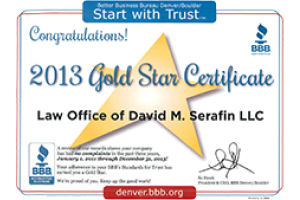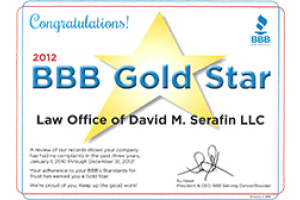Bankruptcy Myths
What About Bankruptcy Should You Know
The bankruptcy process seems intimidating. Many people believe that bankruptcy can hurt both their future permanently and their reputation. However, many bankruptcy myths can be dispelled.
An experienced Denver bankruptcy lawyer, David M. Serafin, will first explain to you the bankruptcy processm what bankruptcy is and is not, and how bankruptcy can eventually help your overall financial situation.
Bankruptcy Myths
Among the most prevalent bankruptcy myths are the following:
Myth #1 — With the Recent Changes to the Bankruptcy Laws, Chapter 7 is no Longer Possible
Not true. Even though the Bankruptcy Code changed in 2005, Chapter 7 debt relief remains a strong option for many in debt. With a Chapter 7 bankruptcy, most non–priority, unsecured debts are discharged and you get more financial freedom.
Myth #2 — My House, Vehicle and Personal Property Will be Taken if I File for Bankruptcy
False. With either a Chapter 7 bankruptcy or Chapter 13 bankruptcy, a pending foreclosure or repossession can be immediately stopped. With a Chapter 7 bankruptcy, a debtor can keep a house, multiple vehicles and personal property, if current on secured debt payments and if the property value is exempt. With a Chapter 13 Bankruptcy, a debtor can also keep a house, multiple vehicles and personal property, through a debt payment plan, even the debtor is behind on monthly payments and/or owns non–exempt property. Our office will help you determine which chapter of bankruptcy (if any) option is appropriate.
Myth #3 — I’ll Need to Repay all Debts I Owe with a Chapter 13 Bankruptcy
Not necessarily. With a Chapter 13 payment plan, Attorney David M. Serafin can petition the Colorado Bankruptcy Court to reduce debts owed to certain secured and unsecured creditors to protect your real and personal property. Although not uncommon, it’s usually not the case that you’re required to pay back all of your unsecured debts in Chapter 13 Bankruptcy as chances are that you won’t have high enough net income (after personal expenses) to pay everybody back even spread out over five years. Unsecured creditors will often only receive pennies on the dollar from the Trustee distribution of the Plan payments over this 3 year to 5 year Plan.
Myth #4 — I can Only File for Bankruptcy One Time
Not true. If you have already filed for Bankruptcy and obtained a discharge, you can usually file again. For instance, the waiting period from Chapter 7 filing to a later Chapter 7 filing is eight years (this starts from the original filing date, not the later discharge date). The waiting period from a Chapter 7 to a latter Chapter 13 case (usually with only a three year Plan) is only four years. Either way, you will want to notify me especially of any Bankruptcy filings within the last eight years (in any state, not just Colorado) as well as the outcome of that case.
Myth #5 – Bankruptcy is too Expensive
Not true. The Law Office of David M. Serafin makes the bankruptcy process easy for you. We guide you through the entire bankruptcy process and help ensure that financial future quickly improves.





